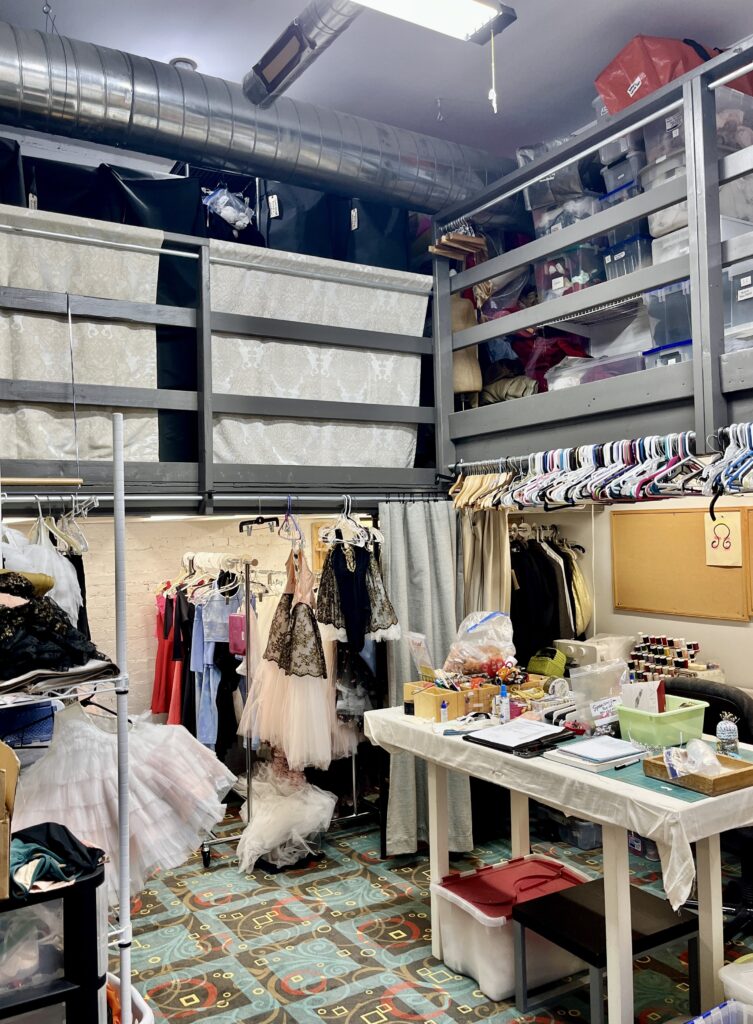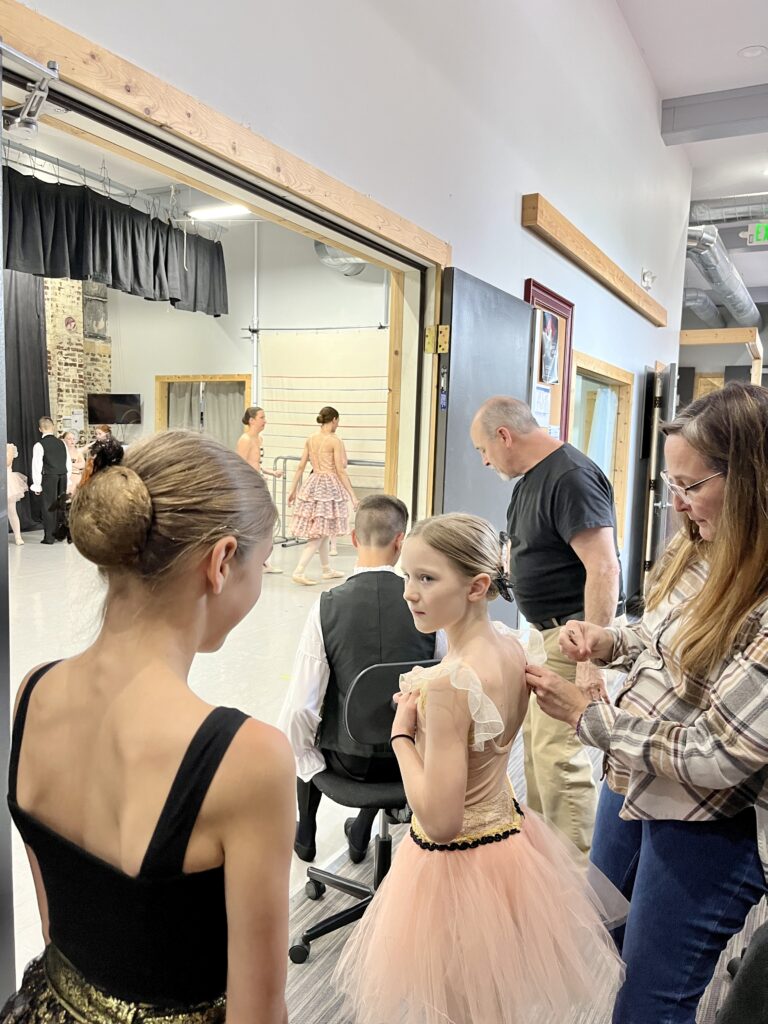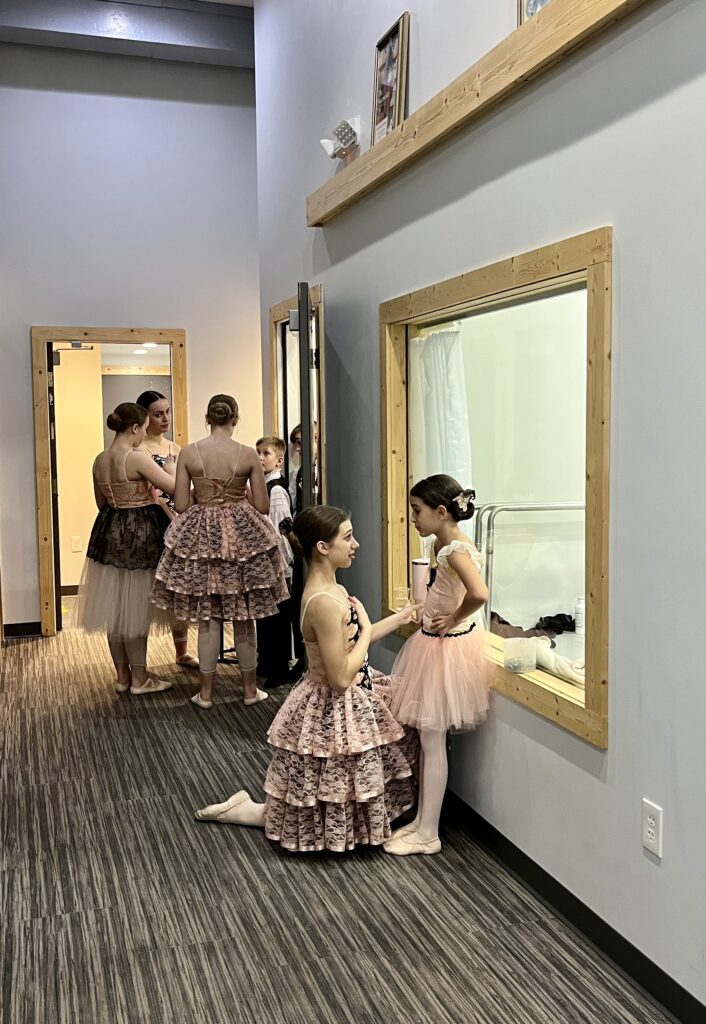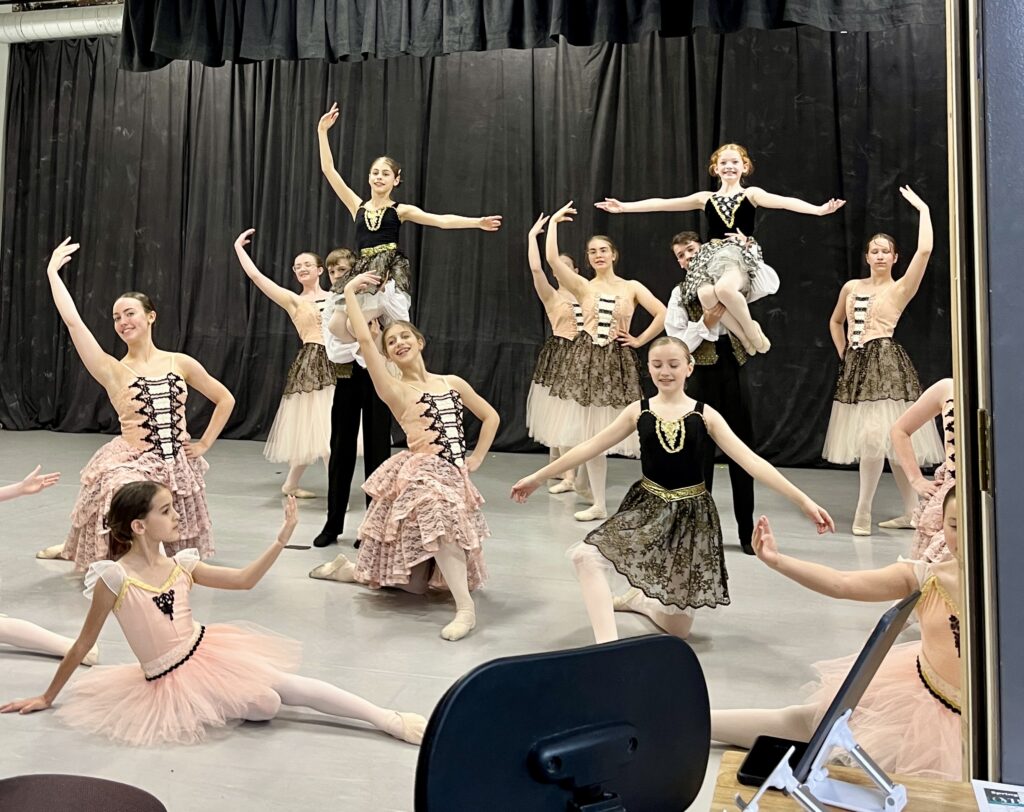Four o’clock hits and Central Ohio Youth Ballet dancers swarm the costume shop to grab their tutus, vests, and hairpieces for their first Don Quixote dress rehearsal. A cluster of blond and brunette sock buns form a line in front of parent volunteers Abby Baird, 39, and Amy Parsons, 50. The moms assist each dancer, locating costumes while asking if alterations need to be made.
Baird stands in the jungle of clothing racks, sifting through circular plastic name tags and puffy tulle skirts. The moment each dancer gets their hands on their garments, they scurry around the corner and down the hall to change in the dressing room. Every other minute, a dancer returns to the shop asking about ill-fitting items and broken threads. Each of their worries is remedied within seconds.
These weekly Sunday rehearsals at the Central Ohio Youth Ballet (COYB) prepare dancers for their upcoming spring performance, “Dance Alive! 2024.” This year’s show, with performances on May 10 and 11 at the Woodward Opera House in Mount Vernon, will feature ballet and modern pieces, along with a succession of 11 dances inspired by the ballet rom-com, Don Quixote.
Weekdays are for dancers to train to advance their ballet technique, while weekends are for scheduled rehearsals. Preserving rehearsals for the weekends forces young dancers to memorize the choreography, preparing them for work in a professional dance environment, explained COYB founder and artistic director Bob Cole.
Costumes and community
Dancers are now in costume and return to the main hallway to enter the dance studio.
Pointed toes glide and leap over the glossy marley floor. Dancers pause practicing their moves and listen closely as Cole begins rehearsal.
“Do it full out, okay?” Cole asks before turning on the music.
The teenage girls are dressed in pink vintage-patterned bodices with black and white sequin embellishments. Their white tulle tutus are adorned with either sheer black overlays or three layers of pink ruffled lace.
The pre-teen girls sport black and gold leotards with matching black skirts while the youngest girls wear ballerina pink head-to-toe. The boys are dressed in black pants, puffy white button-ups, and new handmade black and gold vests.
Baird and Parsons have spent weeks sewing and constructing costumes for the 25 dancers in the show –– and each dancer wears 1-5 costumes. The bulk of their seamstress work takes place in the costume shop which resides behind the welcome desk by the studio’s entryway.
Despite its high ceilings, the reserve of old costumes, hangers, and craft materials makes the room feel small.

The room is stocked with boxes, bins, and silver clothing racks, each one filled with clothing ranging from cloud-patterned athletic gear to romantic tutus. A cylindrical stack of multicolored tutus sits in the corner while a high table positioned near the center of the room houses a large green sewing mat, notebooks and notepads, pin cushions, unopened ballet tights, and bins holding miscellaneous sewing supplies.
Cork boards decorate the costume shop wall behind two Kenmore sewing machines. Pinned to them are a ballet costume list, an enlarged drawing demonstrating how to sew a hook and eye, and a panoramic photo of all of the dancers, in height order, performing in the spring show.
Dancers’ parents volunteer to staff the costume shop during all hours of the rehearsal day.
“Abby and I probably spend 10 to 12 hours in here a week,” Parsons said, and Baird added that volunteers spend between 80 and 100 hours working on costumes for each show.
Costumes at COYB don’t cost the dancers a dime. Due to the accumulation of costumes since the company’s founding in 1994, seamstresses can repurpose old inventory to match the director’s artistic vision and fit cast measurements. If none of the options fit a dancer’s physique, new costumes are constructed that mirror the rest of the group at no additional cost.
The costume shop volunteers receive extra professional help during winter Nutcracker season. The spring show features around 25 dancers while The Nutcracker consists of over 50, in addition to local community members who act and narrate the Christmas story. Just last year, Baird had a narrator role in The Nutcracker and performed alongside her daughter, Aspen.
“It’s a nice way to use our time,” Parsons says as she sits at the costume shop table, flipping through a spiral-bound notebook filled with student measurements and costume cost calculations. The heading on the page reads, ‘Feathers.’ Juicy costume shop gossip reveals the worst: The recent Amazon order for medium-size white feathers was the wrong size. The costume shop warriors must find a way to do what they do best: Pivot.
Parsons’ and Baird’s daughters, Anya and Aspen, have been dancing together for years. The Parsons’ family dance roster includes two new additions of her sons Brenan and Ollie, dancing for the first time in last year’s Nutcracker.
According to the COYB’s website, the school’s mission is to to “nurture dancers at all stages of proficiency, talent, and desire.” COYB co-founder and choreographer Lisa Cole said the school offers a space for new dancers to “try performing in a world that normally would not offer them the opportunity to perform.”
From stitch to studio
A dancer’s mom hand-sews a tutu while Parsons pins the broken strap of a light pink leotard. It’s their first dress rehearsal, and costume malfunctions are expected.
Bob Cole sits on a folding chair in between the studio doors, sipping coffee out of a mug that reads, “I’m Bob doing Bob things.”
He presses play on his tablet and the Don Quixote soundtrack begins.



Tight tops and heavy skirts add extra weight to their kicks and leaps. The dancers are trying their best to not look fatigued. For some of the older girls, this is hour three in the studio.
Parsons stands in the doorway directly behind Bob, holding a notebook and providing constructive feedback. “Smile!” she yells, reminding everyone to look alive.
Keeping one’s composure can make complex, energy-filled movements look like a breeze — and these dancers have their games faces on. Although their ages range from 8 to 18, when it’s time to rehearse, they’re professional ballet dancers. They take constructive feedback seriously, listen attentively, and are quick to make corrections.
“Up and hold in, up and hold in,” Cole says while demonstrating the proper leg work, scanning the room to make eye contact with the dancers he’s correcting. “Right? Let’s do it.”
Young ballerinas whisper corrections to each other as they passé-jump across the floor. Another COYB choreographer calls out costume notes to Parsons and Baird as she watches the run.
All 25 dancers strike a pose in the center of the marley floor. The music ends, Cole starts talking, and the dancers release their arms in exhaustion. There is no time for applause. The next dress run ensues.
Grace Han writes for TheReportingProject.org, the nonprofit news organization of Denison University’s Journalism program, which is funded by the Mellon Foundation and donations from readers.

